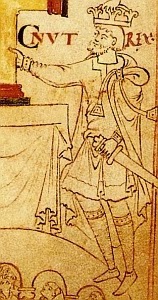I actually finished this tunic about a month ago but I was waiting for the recipient to wear it to an event before I blogged it so I had good pictures of an entire outfit and not just a green tunic. The pattern I used for this was La Fleur De Lyse MAG 1314 “People of Medieval Gothic Period, Years 1240 & 1320.” I made the short, male peasant tunic, which is apparently good for both years. In reality, it’s a pretty generic tunic that can be accommodated to various centuries with variations in accessories and legwear. After much back and forth, my husband went with a much earlier look, based on a image of Cnut from MS Stowe 944, fol. 6r, circa 1031.
In the image, Cnut is wearing a slightly shorter tunic with leg wraps and otherwise seemingly naked legs. According to “Dress in Anglo Saxon England,” and other research I did, while legs weren’t completely bare, it was not uncommon to have short tunics and leg wraps only during this time period. This worked out great for my husband as we live in South Florida and his leg wraps, which I also made, were already made of wool so adding trousers would have been quite warm, and not in a good way.
The pattern itself was pretty straight forward. It’s made up for two front pieces, two back pieces, eight gores, and to sleeves with gussets. It was easy to put together and the pieces went together well. The only alteration I made was purely cosmetic. After I had sewn all the seams and had my husband try the tunic on, he didn’t like the way the center front gore sat with the belt. I took the two pieces of the gore apart from the rest of the tunic and raised the gore about two inches, if memory serves me right. This made the tunic look better. The lower gore I think would work for someone with a much bigger belly or for someone with no belly at all, otherwise it just looks odd with the belt. That took some time but I suspect that once you have made one that fits how you want it, putting a second one together could be done in a matter of hours as it’s really simple construction-wise.
The visible stitching, such as the hems and neckline, is done by hand, but all the seams are machine stitched. The fabric is a linen/rayon blend, which I won’t choose again for other projects but it’s not terrible. I think the tunic looks great, though it needs some embellishment.




Leave a Reply